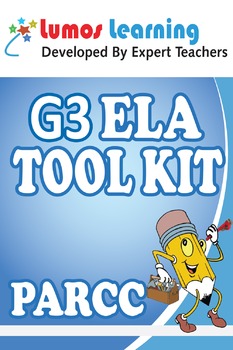Grade 3 English Language Arts (ELA) Tool Kit for Educators, PARCC Edition
Lumos Learning
844 Followers
Grade Levels
3rd, Staff
Resource Type
Standards
CCSSRL.3.1
CCSSRL.3.2
CCSSRL.3.3
CCSSRL.3.4
CCSSRL.3.5
Formats Included
- Open Publication Structure eBook File
Pages
110 pages
Lumos Learning
844 Followers
Description
Grade 3 English Language Arts (ELA) Tool Kit for Educators: Standards Aligned Sample Questions, Apps, Books, Articles and Videos to Promote Personalized Learning and Student Engagement, PARCC Edition
This book is a directory of educational resources that every teacher and parent will find useful while helping their students learn third grade English Language Arts (ELA) skills. It is designed to help educators easily find high quality resources to create personalized learning and differentiated instruction. It not only includes access to several resources developed by Lumos Learning, but also has information about a vast array of apps, books, videos and websites developed by other publishers, teachers and developers.
This guidebook includes:
* Sample questions that are aligned to the Common Core Standards.
* Practice tests similar to the PARCC assessments.
* Lumos EdSearch to discover educational mobile apps, books, videos, Khan Academy resources, library information, and more.
* A special hyperlink to create a free teacher account that has an item bank of hundreds of questions along with additional tools to supplement your classroom instruction.
* Printable worksheets related to various standards.
* Blogs written by expert teachers on a wide range of topics to help teachers and parents.
This book is a directory of educational resources that every teacher and parent will find useful while helping their students learn third grade English Language Arts (ELA) skills. It is designed to help educators easily find high quality resources to create personalized learning and differentiated instruction. It not only includes access to several resources developed by Lumos Learning, but also has information about a vast array of apps, books, videos and websites developed by other publishers, teachers and developers.
This guidebook includes:
* Sample questions that are aligned to the Common Core Standards.
* Practice tests similar to the PARCC assessments.
* Lumos EdSearch to discover educational mobile apps, books, videos, Khan Academy resources, library information, and more.
* A special hyperlink to create a free teacher account that has an item bank of hundreds of questions along with additional tools to supplement your classroom instruction.
* Printable worksheets related to various standards.
* Blogs written by expert teachers on a wide range of topics to help teachers and parents.
Total Pages
110 pages
Answer Key
Included
Teaching Duration
N/A
Report this resource to TPT
Reported resources will be reviewed by our team. Report this resource to let us know if this resource violates TPT’s content guidelines.
Standards
to see state-specific standards (only available in the US).
CCSSRL.3.1
Ask and answer questions to demonstrate understanding of a text, referring explicitly to the text as the basis for the answers.
CCSSRL.3.2
Recount stories, including fables, folktales, and myths from diverse cultures; determine the central message, lesson, or moral and explain how it is conveyed through key details in the text.
CCSSRL.3.3
Describe characters in a story (e.g., their traits, motivations, or feelings) and explain how their actions contribute to the sequence of events.
CCSSRL.3.4
Determine the meaning of words and phrases as they are used in a text, distinguishing literal from nonliteral language.
CCSSRL.3.5
Refer to parts of stories, dramas, and poems when writing or speaking about a text, using terms such as chapter, scene, and stanza; describe how each successive part builds on earlier sections.


